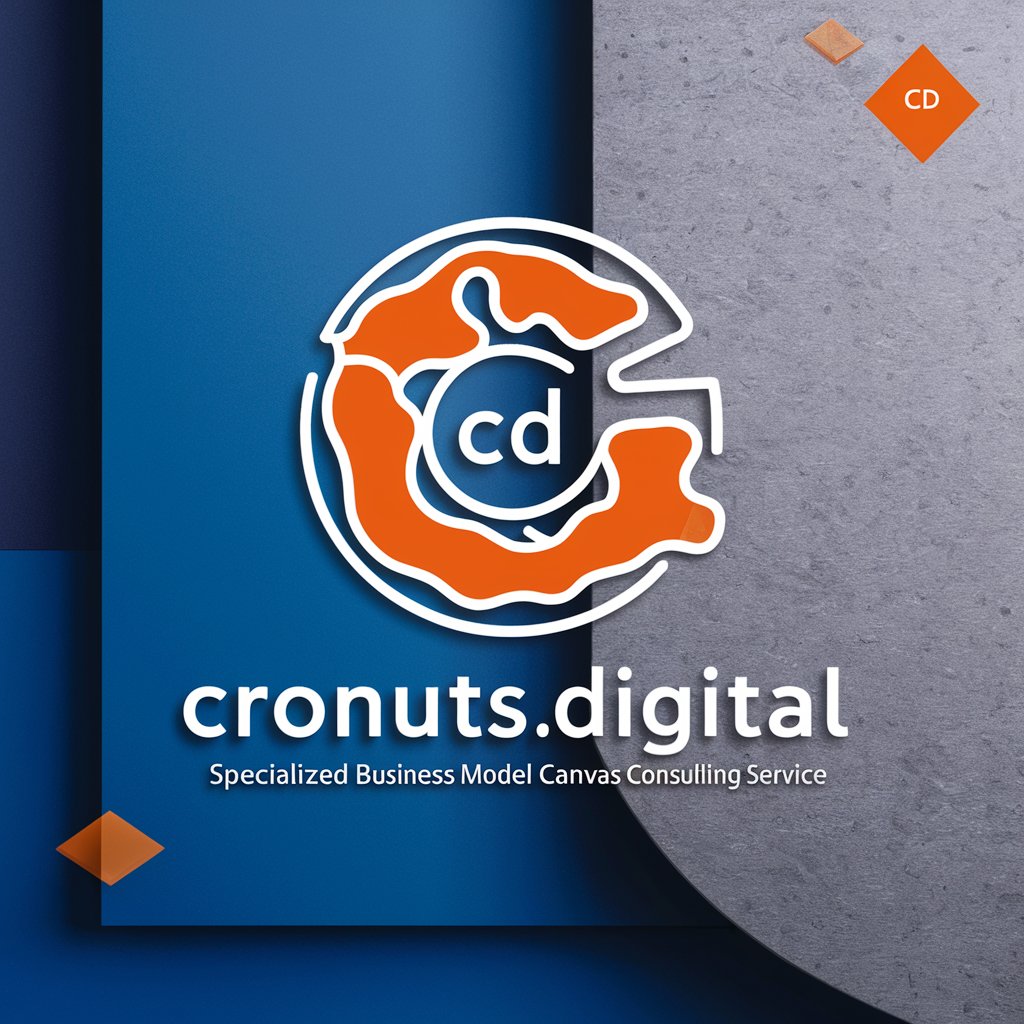
Business Model Canvas - Business Model Design Tool

🚀 CRONUTS.DIGITAL DIGITAL STRATEGY FOR SUCCESS
Strategize with AI, Visualize Success
Outline the key value propositions for a digital marketing strategy targeting small businesses.
Identify the main customer segments for an online marketing consultancy service.
Describe potential revenue streams for a digital strategy consulting firm.
List the essential resources required to deliver top-notch digital marketing consulting services.
Get Embed Code
Overview of Business Model Canvas
The Business Model Canvas (BMC) is a strategic management tool designed to help visualize, discuss, invent, and pivot complex business models. Developed by Alexander Osterwalder and Yves Pigneur, it's a one-page blueprint divided into nine sections: Key Partners, Key Activities, Key Resources, Value Propositions, Customer Relationships, Channels, Customer Segments, Cost Structure, and Revenue Streams. This layout enables organizations to clearly understand their business model in a holistic view, encouraging a strategic approach to business planning and development. For example, a startup might use the BMC to map out the key elements of their business, identifying their main value proposition, customer segments, and how they plan to reach their market, providing a clear path for growth. Powered by ChatGPT-4o。

Core Functions of Business Model Canvas
Visualization of Business Models
Example
A tech startup uses BMC to visualize its business model, showcasing how its app connects freelance graphic designers with small businesses.
Scenario
This helps the team understand the operational and financial aspects, such as the importance of customer service in maintaining relationships.
Strategic Planning and Development
Example
A coffee shop chain employs BMC to strategize its expansion, identifying key partners for local coffee bean sourcing.
Scenario
It highlights the chain's reliance on local partnerships for growth, enabling targeted investments in supplier relationships.
Testing and Validating Business Ideas
Example
An online education platform leverages BMC to test its subscription model, focusing on customer feedback for its courses.
Scenario
By evaluating different revenue streams, the platform can adjust its offerings to better meet market demand.
Ideal Users of Business Model Canvas Services
Startups and Entrepreneurs
These users benefit from BMC's ability to quickly iterate and pivot business models, crucial for early-stage businesses looking to find a viable model.
Established Businesses
For these users, BMC serves as a tool for exploring new markets or products, ensuring that all aspects of the venture are aligned with the overall business strategy.
Educators and Consultants
They utilize BMC as a teaching tool or in consultancy to explain complex business concepts and strategies in a simplified manner.

How to Use Business Model Canvas
Start Your Journey
Begin by exploring the capabilities of the Business Model Canvas without any commitment. Visit yeschat.ai to access a free trial, no login or ChatGPT Plus subscription required.
Understand the Components
Familiarize yourself with the nine key elements of the Business Model Canvas: Customer Segments, Value Propositions, Channels, Customer Relationships, Revenue Streams, Key Resources, Key Activities, Key Partnerships, and Cost Structure.
Sketch Your Business Model
Use a digital tool or a simple pen and paper to draft your initial business model canvas. Focus on outlining your value proposition and how it serves different customer segments.
Validate and Iterate
Gather feedback from potential customers or stakeholders. Use this feedback to refine and adjust your canvas, iterating as necessary to better align with market needs.
Leverage Digital Tools
Utilize digital platforms and tools for collaboration and sharing. This enhances team collaboration and allows for easier adjustments and iterations of your business model canvas.
Try other advanced and practical GPTs
Growth Hacker
Empower Your Growth with AI

Development Interviewer
Ace your tech interviews with AI-powered practice.

Professional Emailer GPT
Streamline Your Email Communication with AI

My Private Therapist🧑⚕️
Empowering personal growth with AI

The Office GPT
Revive Dunder Mifflin with AI

StoryTeller
Craft Tales with AI-Powered Creativity

Fantasy Map Creator
Envisioning Worlds with AI-Powered Mapping

Utforsk Mariannes doktoravhandling
Decoding Identity and Talent with AI

TILT Assignment Creator
Empowering Educators with AI-driven Assignment Design

Viral Content Idea Generator
Crafting Viral Ideas with AI

NM Legal Companion
Empowering Legal Decisions with AI

AI Caddy
Your Personal Growth Companion, Powered by AI

Business Model Canvas Q&A
What is the Business Model Canvas?
The Business Model Canvas is a strategic management tool used for developing new business models or documenting and understanding existing ones. It provides a visual chart with elements describing a company's value proposition, infrastructure, customers, and finances, facilitating a holistic view of the business.
How can startups benefit from using the Business Model Canvas?
Startups can use the Business Model Canvas to clearly articulate their value proposition, identify target customer segments, and outline the key activities, resources, and partnerships required to succeed. It helps in pivoting quickly based on feedback, reducing the risk of failure.
Can established businesses use the Business Model Canvas?
Yes, established businesses can use the Business Model Canvas to explore new markets or products, streamline operations, and enhance their value propositions. It's also valuable for reassessing and realigning their strategies with the changing business environment.
What is the best way to fill out a Business Model Canvas?
Start with the customer segments and value propositions to ensure the business model is customer-centric. Then, move on to define the channels, customer relationships, revenue streams, key activities, key resources, key partnerships, and finally, the cost structure. Collaborative sessions with team members can provide diverse perspectives.
How often should the Business Model Canvas be updated?
The Business Model Canvas should be reviewed and updated regularly, especially when there are significant changes in the market, customer preferences, technology, or when the company is considering new ventures. This ensures the business stays aligned with its strategic objectives.






